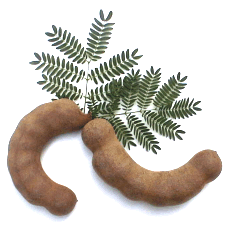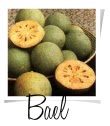Tamarinds have deep roots
in Indian folklore and religion: In Bengal, the Oraons view the tree as sacred
and often buried their loved ones under its shade. Perhaps this is also how
another belief came to be—the one that holds tamarind trees are home to
spirits, and thus travelers should not sleep under them. Malvi Doshi, author of
the book, “Cooking Along the Ganges,” recalls how his father in Gujarat forbid
him from approaching the tree after dusk settled for this very reason. Indians
of the north are not the only ones steeped in tamarind lore: Dravidians of the
south have a ritual performed by the mother of the groom called the “grinding
of the tamarind stone.” Indeed, India’s history is rich with stories and
anectotes featuring this tangy, complex fruit.
Origin of Tamarind
Contrary to its indica classification, the fruit is not
of Indian origin. Though the fruit has grown on India’s soils for many
centuries, tamarinds are native to the tropical regions of Africa—more
specifically, Sudan, Cameroon, and Nigeria. To give an idea of its antiquity,
the Egyptians and Greeks received the fruit much later… and yet, references are
made to the fruit there as far back as the 4th century BC.
The indica name likely came from the Arab traders who coined the fruit
as, “tamar hind,” or, “Indian date.”
Availability of Tamarind in India
Tamarind requires
semi-arid, tropical conditions in which to grow. States and regions growing the
fruit include Bihar, Orissa, Karnataka, Andhra Pradesh, Madhya Pradesh, Kerala,
Uttar Pradesh, Maharashtra, Tamil Nadu, and the lower Himalayas.
India is the largest
producer of fruits, and one of the only nations growing tamarinds on a
commercial scale. No oversight body makes it difficult to know precise figures
of production, but the Punjab National Bank estimates 50,000 tonnes are
produced from Madhya Pradesh alone.
Often in competition with
Thailand, India exports some of its production ships to the US, Europe, and
other parts of Western Asia. Only a fraction of the yearly tamarind yield gets
distributed as fresh fruit: most of it goes to plants to make ready-made pulp;
a key ingredient in several Indian chutneys and curries.
Tamarind production on a
micro level is a bit of an oddity in India—few in the villages gather tamarinds
because they’re likely the low-priced, low-demand sour variety. Furthermore,
the disorganized nature of the market makes it difficult to effectively price
and distribute tamarinds outside of the villages.
Tamarind season depends
on the region. The south gets tamarinds first and the season slowly extends to
the north. Karnataka and Andhra Pradesh yield tamarinds in January; Maharashtra
in February; and northern states like Madhya Pradesh and Uttar Pradesh in late
February.
Where to find Tamarind in India
Tamarinds are readily
found in India, though more so in the north than the south. Metro areas sell
boxes of the sweet type in most mid to large stores, although they’re often
imports from Thailand. Because tamarind markets are so fragmented at the micro
level, the fruit seldom appear on pushcarts alongside oranges, grapes and
bananas during the same season.
It’s quite simple to find
tamarind-related products year-round, such as the blocks of the sour fruit,
tamarind powder, chutney, and ready-made tamarind paste.
Checking for Ripeness in Tamarind
It’s difficult to
determine tamarind’s quality based on its brittle, peanut-like shell. Only once
the exterior is cracked can the quality be determined: the pulp inside should
be sticky to the touch and a dark toffee brown color. Spoiled tamarinds are
dessicated, light in color and sometimes powdered white.
Taste of Tamarind
There are two varieties
of tamarind: sweet, and sour. Though most trees in India yield sour fruits, the
type of tamarind sold fresh to consumers is the sweeter variant.
Tamarinds have a gummy,
sticky texture similar to a date. Its taste is bold and commanding—there are no
subtle, subdued flavors or lingering aftertastes. Tamarinds offer an explosive,
tart flavor similar to a sweet-and-sour candy sold to kids. If tasting the sour
type, expect a puckering sensation akin to eating a lemon or ornamental orange.
Nutritional Value of Tamarind
According to the USDA
nutrient database, 100g of tamarind contains the following values:
239kcal
1g Fat (1% RDI)
28mg Sodium (1% RDI)
63mg Carbohydrate (21%
RDI)
5g Fiber (20% RDI)
2.8g Protein (6% RDI)
30IU Vitamin A (1% RDI)
3.5mg Vitamin C (6% RDI)
2.8mcg Vitamin K (3% RDI)
.4mg Thiamin (29% RDI)
.2mg Riboflavin (9% RDI)
1.9mg Niacin (10% RDI)
.1mg Vitamin B6 (3% RDI)
14mcg Folate (3% RDI)
74mg Calcium (7% RDI)
2.8mg Iron (16% RDI)
92mg Magnesium (23% RDI)
113mg Phosphorous (11% RDI)
628 mg Potassium (18%
RDI)
.1mg Copper (4% RDI)
1.3mcg Selenium (2% RDI)
Health Benefits of Tamarind
Some may hesitate to eat
tamarinds because of its high sugar content, and yet, the fruit is packed per
gram with calcium, iron, thiamin, magnesium, potassium and fiber. In fact, the
United States imports tens of thousands of kilos of tamarinds for medical
studies and for pharmaceutical applications.
According to the book,
“Ayurvedic Healing Cuisine,” tamarinds have several traditional health benefits
in India: they treat thirst, jaundice, liver problems, cholera, and soothe the
throat. Tamarinds act as a potent laxative, and aid digestive issues like
gastritis and colic pain. For men, the seeds treat impotence and seminal
diseases.
Some Indians also use
tamarinds as part of a beauty regiment: when applied topically, the seed powder
prevents the formation of pimples and serves as a type of hair oil.
The book, “Fruits of Warm
Climates” outline worldwide traditional remedies as well. Tamarinds reduce fevers
and act as a carminative. Several countries apply the pulp topically to combat
inflammation, and consume it to treat sunstroke, hangovers, parasites, and even
paralysis.
Scientific studies show
promising findings regarding tamarinds:
--According to a 2012
study published in the Journal of Natural
Medicines, tamarinds illustrated anti-obesity
effects by improving lipid profiles and boosting antioxidant efficiency in obese rats.
--A 2010 study published
in Scientia Pharmaceutica affirms the
leaves’ traditional use as an anti-inflammatory
and antinociceptive.
--As
per a study published in the Journal of
Pharmacy and Bioallied Sciences, tamarind seeds show potent anti-ulcer activities by regulating
gastric juices and reducing the total acidity in gastric secretions.
--Remarkably, a 2012
study published in the Scientific World
Journal found that the seeds act as an anticancer
agent by reducing human cancer cells and tumor
sizes.
--According to a 2006
report published by the Southampton Centre for Underutilized Crops, tamarind
fruit extracts exhibited antifungal
activities against Candida albicans. The
report also cited a study indicating the seed’s potent efficacy as an antidiabetic when tested in rats.
--A 2012 study published
by the Journal of Hazardous Materials found
a promising use for tamarind shells, as their calcium-rich compounds may assist
with fluoride removal in ground water.
--A 2008 study published
in the Asian Journal of Biochemistry
found that tamarind pulp exhibited potent antibacterial
activity when tested against strains of gram positive and gram negative
bacteria such as Staphylococcus aureus,
Escherichia coli, and Pseudomonas
aeruginosa, thus affirming many of its uses in traditional remedies.
How to Open/Cut:
The pulp comprises only 30
to 50 percent of a tamarind. Thus, a bit of preparation work is required to get
to the edible part of a tamarind. First, crack the brittle brown shell of the
fruit—this process is no different than cracking a groundnut shell to get to
the peanuts. Next, extricate the pulp from the fibrous ribbing: pinch the
ribbing at the point of each tamarind and peel it away from the tamarind
flesh—ideally, the twiggy ribbing comes off in one smooth pull. Enjoy the pulp,
but be mindful of the two to six shiny black seeds waiting in every
tamarind. The white, papery skin
surrounding each seed is edible though tasteless.
Here’s a video showing how to peel and eat a tamarind.
Storage:
Tamarind pods are
low-maintenance fruit: even at room temperature, they will keep for a month.
Store homemade tamarind pulp by blending it with salt and placing the
concoction in an airtight container. Tamarind paste keeps for years in dry
conditions.
To reduce any probability
of mold and spoilage (as might be the case in balmy, humid conditions with
super-fresh tamarind), consider freezing tamarind paste in ice cube trays and
popping them out as needed.
Tamarind Recipe Ideas and Uses:
--The
sour pulp is often used for curries
and sauces as a souring agent. In
some cases, tamarind pulp gets folded into curry and chutney recipes as a sort
of cranberry/raisin substitute.
--The sweet tamarind pulp
is processed for jams, sweets and
the occasional soup recipe.
*Make tamarind chutney by simmering the pulp with
dates, ginger, sugar, and earthy spices like cumin.
--South Americans,
Central Americans and those in the Caribbean make popular sodas and juices. Ghana,
for instance, adds sugar and honey to tamarind pulp for its version of the
sweet beverages. Other countries ferment the pulp to make a type of alcohol.
*To make a tamarind
cooler, simply boil water and add it to a base of dissolved sugar, tamarind
pulp and lemon juice. Add additional flavors as desired, such as mint and
ginger.
--In Mexico, the sour
pulp gets sweetened with sugar and rolled in chili powder for caramel apples and chewy candy.
--Tamarind
kernels contain a gel-forming substance that may be useful as a stabilizer for
mayonnaise, jams, ice cream, soups and sauces
--The tamarind seed may
be ground into flour for use in baked goods and pastries.
--Tamarind is the base of
several barbeque sauces, thanks to
its earthy, sweet-and-sour taste. Make a barbeque glaze by adding tamarind
paste or concentrate with agave (or honey), soy sauce, cumin, ginger, and black
pepper. Add nut butter (almond or peanut) to create a creamier dipping sauce.
 |
| Vegan beans with tamarind and chipotle from sproutsinthehood.blogspot.com |
Flavor Complements:
Orange, lemon, lime,
apple, amla, star gooseberry, passion fruit, date
Herbs, spices, and oil: ginger, salt, black pepper, white pepper, vinegar,
barbeque sauce, chili powder, coconut oil, garlic, onion powder, molasses,
jaggery, palm sugar, honey, cumin, turmeric, coriander, mustard seed, anise,
lemon juice, lime juice, tomato paste, mint, cinnamon, nutmeg, cardamom,
fennel, asafetida, salt,
Random Facts:
Indian farmers have an
interesting relationship with tamarinds. According to a “Times of India”
article, the British planted many of the trees during the early half of the 20th
century—Indian farmers hold the belief that tamarind trees adversely affect
health, particularly asthmatics. Thus, farmers seldom plant them.
Americans are more
familiar with the fruit than they might believe: tamarind is a key ingredient
in Worcester sauce.
Scientific Name:
Tamarindus indica
Other Names:
Amli (Bengali)
Imli (Hindi)
Puli (Tamil)
Chinta (Telegu)
Chinch (Marathi)
Related Fruits:
Tamarinds
are related to some types of string beans, unsurprising given their appearance.
















Hi,
ReplyDeleteIs there any website where one can buy tamarind seeds online.
Thanks
Celli
Good information
ReplyDeletewhich tamarind(big or small) is more beneficial for men ?
ReplyDeletepg slot รับฟรีเครดิต ผู้ให้บริการเกมสล็อตออนไลน์ ที่มาแรงที่สุด pg slot รับรองความคุ้มราคาจากถ้าเกิดคูณเริ่มจะมีความรู้สึกว่าของฟรีไม่มีในโลก บอกเลยว่าคุณคิดผิดแล้ว ด้วยเหตุว่าเว็บไซต์ของเราแจกจริงไม่ต้องแชร์
ReplyDeletefdse
ReplyDeletegrst
ReplyDelete